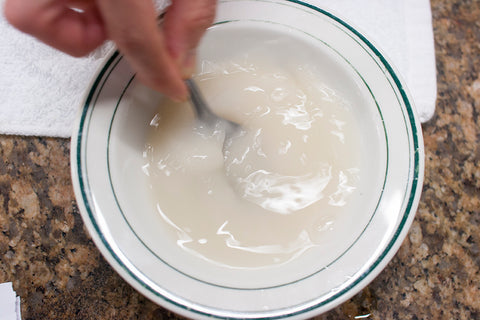Great pizza starts with the right dough. Brian, our wholesale manager, has spent countless hours developing his special dough recipe and has been kind enough to share his secrets. Featuring Caputo 00 Flour, Brian’s dough provides the perfect canvas for any pizza.
From the dough, to the sauce and the toppings, shop all of Ditalia's Pizza Essentials Here!
INGREDIENTS
250 grams Caputo 00 Flour (about 2 cups)
1/4 cup warm water
1/2 cup cool water
1/4 tsp Active Dry Yeast
1 tsp Fine Sea Salt
1/2 tsp Granulated Sugar
PREPARATION

Dissolve the yeast in warm water with the sugar. In a standing mixer bowl, add the cool water and dissolved yeast.

With the mixer on slow speed, using the paddle blade, add about 1/3 or so of the Caputo 00 flour and mix (increasing the speed) for a minute or two, until a smooth “batter” forms. This helps to develop the gluten in the dough.

Add remaining Caputo 00 flour and salt. Once the dough comes together, switch to a dough hook and use a slow/med speed to kneed the dough for 8-10 minutes.
First Proofing
Form dough into a ball and transfer to a bowl lightly oiled with extra virgin olive oil and cover with plastic wrap until rested and has slightly grown in size (approx 1.5 hours). Since very little yeast is used, the dough shouldn’t double in size, as is common for bread recipes.

Second Proofing
Remove dough from bowl and portion into two dough balls. Place on floured sheet pan, cover well with plastic wrap and a towel to make a tight seal, and refrigerate for 24 hours.

Remove dough balls from fridge 1.5 hours prior to making pizza. This allows the dough to reach room temperature, making it more workable.
HELPFUL TIPS
An alternative / quicker method is to forgo the 2nd long proof in the fridge and instead proof the dough the 2nd time at room temp (approximately 4 hours) Care must be taken so that the dough balls do not over proof (ie more than double in size). If it appears the dough would be ready too soon, it can simply be put in fridge to slow down the growing dough a bit. The goal is to have the dough “rise” in the oven – and making sure the dough doesn’t “over proof” is key!
The longer (refrigerated) second proofing yields a more favorable crust that tastes less “yeasty” & is definitely worth the extra preparation day.
The sugar simply helps with the browning of the crust in a conventional oven that tops out at about 500 degrees.
Use a baking stone or baking steel. Preheat oven for an hour at the maximum temperature prior making pizzas.
PIZZA ESSENTIALS

From the dough, to the sauce and the toppings, shop all of Ditalia's Pizza Essentials Here!
46 comments
I like a thicker crust, and I only have have a 550 degrees F maximum oven. I think I have perfected (at least for my raised-on-mom&pop-pizzeria-pizza in NY State taste) a thicker crust based on Brian’s recipe.
Ingredient changes
- Instead of a level 1/4 tsp of yeast, a slightly heaping 1/4 tsp.
- Instead of a level 1/2 tsp of sugar, a slightly heaping 1/2 tsp.
- Add 1 tbsp of good olive oil.
Cooking/handling changes
- Make one ball instead of two for an 11” – 12” pie. I double or triple the recipe and make extra pies.
- Use slices of fontina or fresh mozzarella to cover the pie except for the edges, and put the sauce and toppings on top of that. This way the top of the crust doesn’t come out soggy and the cheese stays creamier. I like to use good homemade or Rao’s jarred pizza sauce and heat it slowly to thicken it a little.
- Start the oven at 550 to get it and the stone good and hot, but turn it down to about 450 when you put the pizza in. Bake for about 8 minutes until the edges are golden brown. Turn it around halfway through if needed to even out the browning. I also turn the broiler on for a minute or so.
- Let the pie cool to room temperature. When you’re ready to eat it, preheat the oven and stone again to 550 then turn it off. Put the pie in for about 2 1/2 minutes to add a thin layer of nice crispiness to the bottom.
I am looking how to freeze Capto “00” pizza dough with toppings for later cooking.
Any body doing this?
All my Capto (Blue) “00” dough balls are refrigerated for at least 3-4 days.
Thanks,
PeteW
Some of the problems people are experiencing with wet dough probably comes about by different ‘cup’ sizes – a cup is 236ml not the averaged cup of 250ml used in many recipes and indeed on the internet when searching for MLS in a cup!
My dough came out delightfully easy and now in the fridge awaiting……
By far my favorite recipe so far for household oven cooking! Delicious flavor and restaurant quality presentation.
This recipe as written is far too sticky. Needed to add much more flour than originally weighed. Perhaps recipe needs water weights and not cup measurements
Viewing 5 of 46